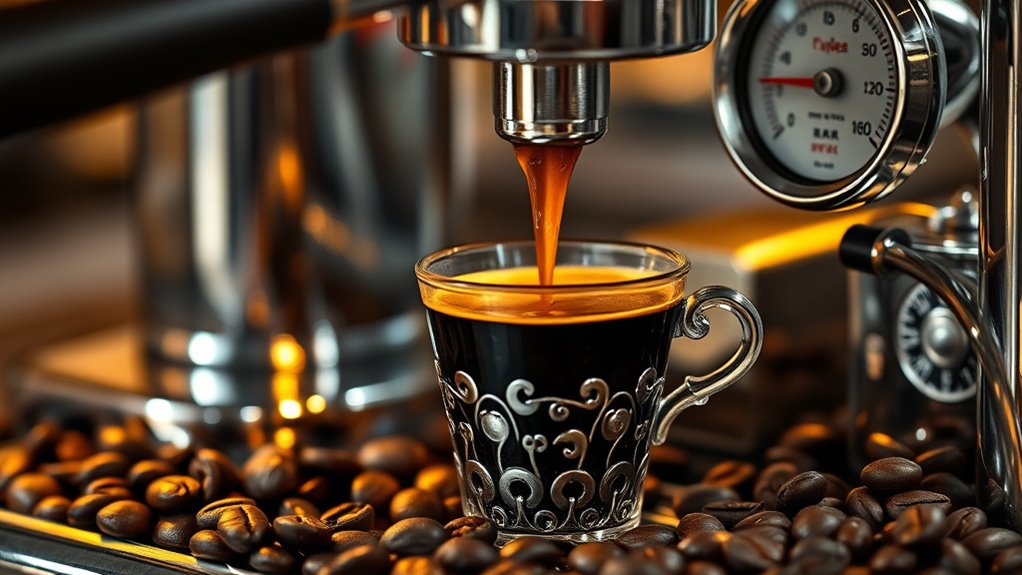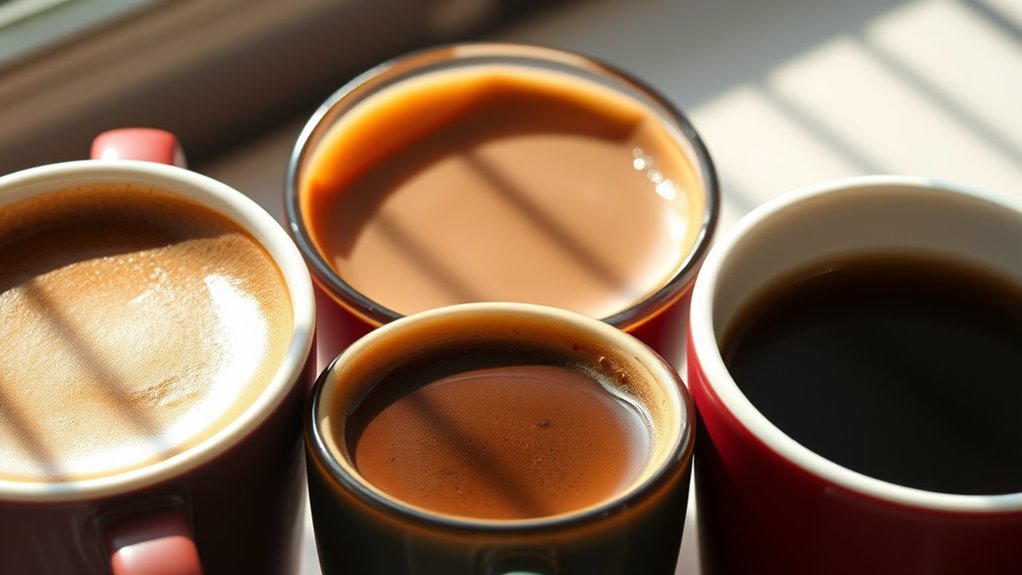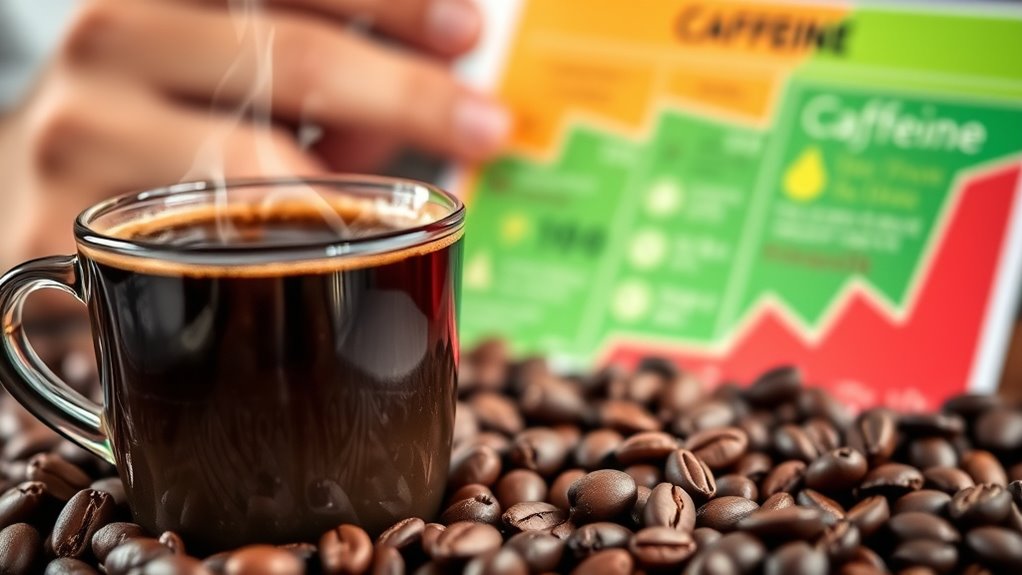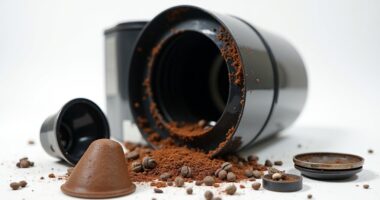Cuban coffee’s strength is like a little jolt of joy in a cup! It all starts with the Moka pot, which brews that strong, rich flavor. You’ve got dark roast beans lending boldness, and fine grinds boosting the caffeine extraction. It’s like a flavor explosion! Plus, sugar foam adds sweetness that’ll make you smile. So, if you want to impress your friends with your coffee knowledge, stick around—there’s more tasty stuff to explore!
At a Glance
- Cuban coffee is brewed using a Moka pot, which enhances flavor extraction and produces a strong, rich brew.
- The fine grind size of coffee grounds increases caffeine extraction, making Cuban coffee stronger than regular coffee.
- Dark roast beans used in Cuban coffee provide bold flavors and a rich body, contributing to its intense taste.
- A blend of Robusta and Arabica beans combines strength with sweetness, creating a unique flavor profile.
- The brewing technique and sugar foam (espumita) enhance the coffee’s strength and sweetness for a potent experience.
Brewing Technique: The Role of the Moka Pot

When it comes to brewing Cuban coffee, the moka pot is like your trusty sidekick, ready to whip up a strong cup of magic! This aluminum gem fills the air with rich aromas as you heat it up.
Start by filling the base with water, add your coffee grounds, and let that brewing process unfold. Remember, a light tamp helps with extraction, but don’t go overboard!
Keep an eye on it—remove it just as those first drops appear for the best flavor. With a little sugar foam, your coffee’s strength and sweetness will blend perfectly, making each sip a delight! Additionally, the decaf espresso brewing technique can highlight the unique flavors of coffee without the jitters.
Caffeine Content: Understanding Levels in Cuban Coffee
If you thought the moka pot was your only secret weapon for strong Cuban coffee, wait until you hear about the caffeine content!
A typical 8-ounce cup packs 100 to 120 mg of caffeine, which is more than regular coffee. Those little 2-ounce cafecito shots? They deliver a solid 60 to 80 mg!
Cuban coffee’s fine grind and brewing method boost caffeine extraction, making every sip count. Additionally, the brewing methods used in Cuban coffee preparation enhance the overall flavor profile and strength.
The Impact of Dark Roast Beans

Dark roast beans are like the rockstars of the coffee world, and Cuban coffee takes this to a whole new level!
These beans are roasted until they’re deep brown, almost black, giving them that glossy sheen. This dark roast brings a bold flavor profile, full of smoky notes and a rich body that’s hard to resist.
You’ll notice hints of chocolate and nuts dancing in the background, too. Plus, the brewing process pulls out those delicious oils and sugars, making your cup even stronger. Additionally, the unique characteristics of Kona coffee can enhance your appreciation for different coffee styles.
Grind Size: How Finer Grinds Enhance Strength
Ever wondered why Cuban coffee packs such a punch? It’s all about that fine grind!
With finer grinds, you get more surface area, boosting flavor extraction and caffeine kick. Cuban coffee nails that grind consistency, striking the perfect extraction balance.
Finer grinds mean more surface area, enhancing flavor and caffeine extraction—Cuban coffee masters this perfect balance!
Too coarse? You’ll end up with a weak brew that leaves you wanting more. But go too fine, and bitterness might sneak in—yikes!
The moka pot loves those fine grounds, creating that rich, velvety *espumita* we all adore. Additionally, Colombian coffee beans are known for their delightful flavor profiles, making them a fantastic choice for those who appreciate a robust cup.
Pressure and Temperature in Brewing

You know that moment when you take a sip of Cuban coffee and it hits you like a warm hug? That’s the magic of brewing pressure and temperature control!
Here’s how they work together:
- Moka Pot Pressure: It brews at 1–2 bars, extracting more flavor than drip coffee.
- Hot Water: Near-boiling temps (around 212°F) enhance that rich taste.
- Quick Brew Time: It only takes 2–5 minutes to get that robust cup.
- Gentle Packing: A light press helps maintain ideal pressure for the best extraction.
Additionally, the unique Cuban coffee brands used often play a crucial role in the strength and flavor profile of the brew.
Cultural Significance: Coffee as a Social Ritual
Coffee isn’t just a drink in Cuba; it’s a whole vibe! Imagine this: you’re at a family gathering, everyone’s sharing stories over tiny cups of cafecito, laughter filling the air.
Coffee in Cuba isn’t merely a beverage; it’s a vibrant experience that weaves together stories, laughter, and community.
That’s the magic of coffee as a cultural ritual! It’s all about community bonding, connecting generations, and making memories. When you serve cafecito to guests, it’s like saying, “Welcome to my world!”
Plus, it’s a social equalizer—everyone’s included, no matter their background. Whether it’s a daily pause or a celebration, every sip brings you closer to your roots and to each other. In fact, many people enjoy their coffee with non-dairy creamers, enhancing the flavor and making it a delightful experience.
Coffee’s not just strong; it’s a lifeline!
Comparison to Espresso and Regular Coffee

When you think about coffee, you might picture those giant mugs of drip coffee from your local café, right?
But let’s explore the world of Cuban coffee and see how it stacks up against espresso and regular brews:
- Cuban coffee packs 60-80 mg of caffeine per shot, similar to espresso.
- An 8-ounce cup can hit around 100 mg, rivaling regular coffee.
- The fine grind and dark roast enhance caffeine extraction.
- Brewing innovations like the Moka pot create bold flavors, a nod to Cuban traditions.
- The quest for the perfect coffee bean is crucial, as the quality of beans directly influences the strength and flavor profile of the brew.
Preparation Techniques: Sugar and Foam
If you’ve ever sipped a cup of Cuban coffee, you know it’s not just about the caffeine kick; it’s all about that sweet, creamy foam on top.
To nail that perfect foam, you need to focus on sugar ratios. Mixing a heaping amount of sugar with the first drips of espresso creates a thick paste, essential for foam stability. The more vigorous you mix, the lighter and creamier it gets!
Use granulated or unrefined cane sugar—no substitutes allowed! Trust me, you’ll want that rich flavor. Additionally, using the right espresso tamper technique can help achieve a more consistent extraction, enhancing the overall coffee experience.
Health Considerations for High Caffeine Intake

While many of us love that jolt of energy from a strong cup of Cuban coffee, it’s important to keep an eye on how much caffeine you’re downing.
Here are some key health considerations to watch out for:
- Increased heart rate and blood pressure.
- Higher levels of anxiety and stress.
- Trouble sleeping and insomnia.
- Withdrawal symptoms like headaches and irritability.
Following health guidelines suggests keeping your caffeine intake below 400 mg daily. Additionally, switching to low acid coffee can help reduce stomach discomfort while still allowing you to enjoy your favorite brews.
So, enjoy your Cuban coffee, but remember, moderation is key!
Let’s keep those caffeine effects in check and stay energized without the jitters!
The Importance of Quality and Bean Origin
You’ve probably experienced that delightful kick from your Cuban coffee, and a big part of what makes it so special is the quality of the beans and where they come from.
The bean selection is no joke! Grown in the Sierra Maestra and Escambray mountains, these beans soak up the terroir influence, making them rich and flavorful. Hand-picked by local workers, they guarantee exceptional quality.
Cuban coffee blends often mix bold Robusta and smooth Arabica, giving you that strong, earthy kick with a hint of sweetness. It’s like a warm hug in a cup, connecting you to Cuban culture with every sip! Additionally, the best Brazilian coffee brands also emphasize high-quality beans, showcasing the global importance of premium coffee sourcing.





